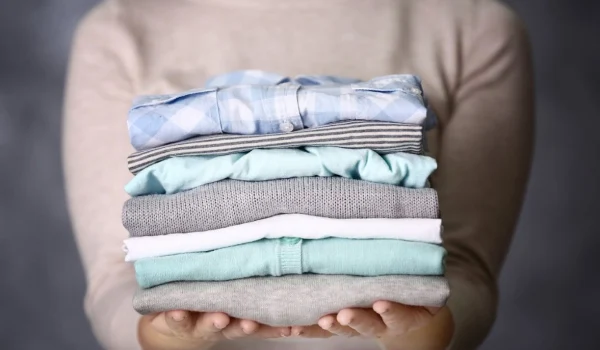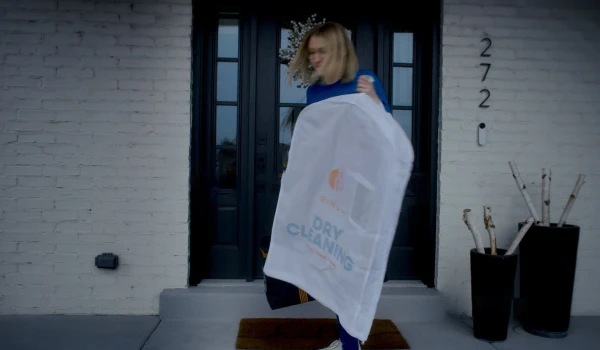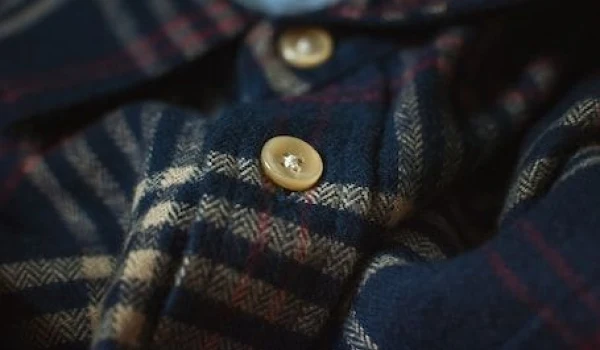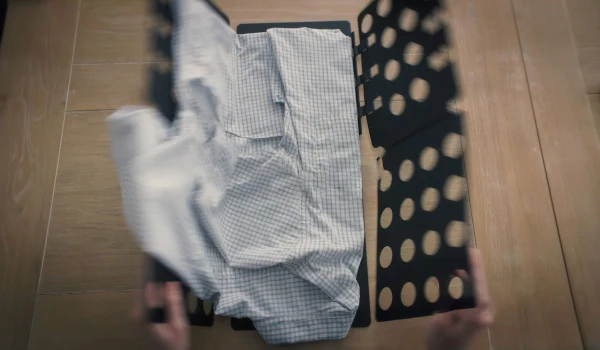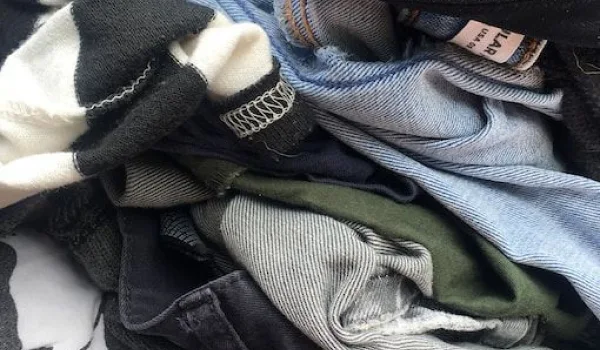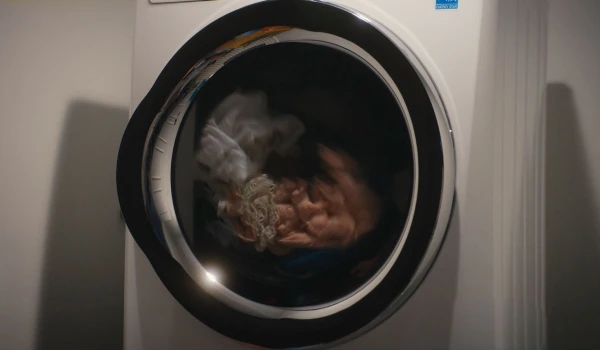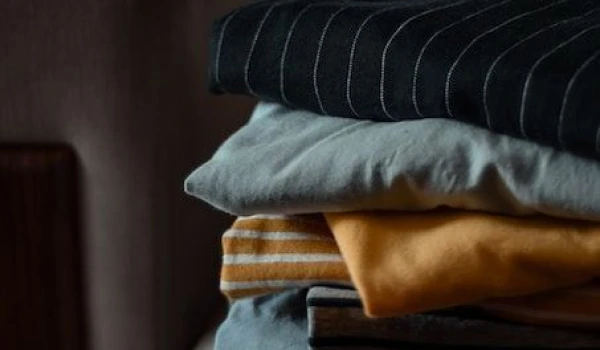Care
Clothing care tips to make your wardrobe last

What Is Linen?
Linen is one of the oldest and most revered fabrics in the world, tracing its origins back thousands of years to ancient civilizations. Derived from the flax plant, linen has been a staple of both everyday and luxury textiles for centuries. Known for its natural elegance, linen is celebrated not only for its aesthetic appeal but also for its unique properties that set it apart from other fabrics.
Linen is a natural fabric characterized by its strength, durability, and breathability. Its fibers are longer and thicker than those of cotton, giving linen a distinctive texture and a slightly rougher feel. However, it's this very texture that makes linen so desirable, as it softens with each wash while retaining its structural integrity. The breathability of linen fabric allows it to wick moisture away from the body, making it a popular choice for warm-weather clothing and bedding. Additionally, linen is hypoallergenic and eco-friendly, further solidifying its status as a premium material.
Linen's versatility extends beyond clothing to include a wide range of products such as tablecloths, curtains, and even upholstery. As a home textile, linen’s natural luster and drape add a touch of sophistication to any space and as consumers continue to seek sustainable products, linen remains a top choice for those who value both beauty and functionality.

Does Linen Shrink When Washed?
One of the most common concerns about linen fabric is whether it shrinks when washed. The answer is yes, linen does tend to shrink, especially if not washed under the right conditions. Understanding the factors that contribute to linen shrinkage can help you better care for your linen garments and home textiles.
Water Temperature
Water temperature plays a crucial role in the washing process of linen fabric. Linen is sensitive to high temperatures, and washing it in hot water can cause the fibers to contract, leading to shrinkage. We recommend washing linen in cold water or lukewarm water to minimize the risk of shrinking. Cold water helps maintain the fabric’s size and shape, while lukewarm water can be used for more thorough cleaning without causing significant shrinkage.
Washing Techniques
The method you use to wash your linen clothes can also affect the extent of shrinkage. Gentle washing is key when it comes to maintaining the integrity of linen fabric. Avoid vigorous washing cycles that can agitate the fabric too much. Instead, opt for a gentle cycle on your washing machine, or better yet, hand wash your linen garments. Hand washing allows you to control the pressure applied to the fabric, reducing the shrinkage risk.
Detergents
The type of detergent you use can significantly impact the condition of your linen garments. Harsh detergents contain chemicals that can weaken linen fibers, making them more susceptible to shrinkage. It’s best to use a mild detergent that is free from bleach and other harsh additives. A mild detergent will clean your linen thoroughly while being gentle on the fabric. Also, avoid using fabric softeners as they can leave a residue that diminishes the natural breathability and texture of linen.

Does Linen Shrink When Dried?
The drying process is another critical factor that affects the shrinkage of linen. Linen is particularly sensitive to heat, and improper drying can lead to significant shrinkage and damage to the fabric.
The Influence of Heat
Heat is one of the primary culprits behind linen shrinkage. When linen is exposed to high temperatures, whether in the washing machine or dryer, the fibers can tighten and shrink. This is why it’s crucial to be cautious when drying linen clothes and other linen textiles. Avoid using high heat settings on your dryer, and opt instead for a low or no-heat tumble dry setting if you choose to use a dryer at all.
Air Drying vs. Machine Drying
Air drying is our preferred method for drying linen, as it minimizes the risk of shrinkage and helps preserve the natural texture of the fabric. To air dry, simply hang your linen items in a well-ventilated area away from direct sunlight, which can cause discoloration. If hanging is not an option, you can lay the linen flat on a clean, dry surface to dry naturally. This method allows the fabric to retain its shape and prevents the fibers from becoming overly compressed, which can happen in a dryer.
Machine drying, while convenient, should be approached with caution when it comes to linen. If you must use a dryer, select a low heat setting and remove the linen items while they are still slightly damp to finish drying them flat. This technique can help reduce the risk of shrinkage while still providing the convenience of machine drying.

How To Take Care of Linen
Taking proper care of your linen garments and textiles ensures they remain beautiful and functional for years to come. Here are some practical tips for effective linen care:
Gentle Washing
Always opt for gentle washing methods to maintain the quality of your linen. Whether you choose to hand wash or use a machine, ensure that the washing cycle is gentle and the water temperature is appropriate. Avoid overcrowding the washing machine, as this can cause undue stress on the fabric and lead to wrinkling or even shrinkage.
Air-Drying
Whenever possible, air-dry your linen items. As mentioned earlier, air drying is the best way to preserve the fabric’s natural properties and prevent shrinkage. If you’re short on space or time, a low-heat tumble dry can be used, but be sure to monitor the drying process closely to avoid overheating.
Ironing With Care
Linen tends to wrinkle easily, which is part of its charm. However, if you prefer a smoother appearance, ironing can help. When ironing linen, do so while the fabric is still slightly damp for best results. Use a medium to high heat setting and press with a steam iron to remove wrinkles. Always iron on the reverse side to protect the fabric’s surface.
Avoiding Fabric Softeners
Fabric softeners can coat the fibers of linen, reducing its breathability and natural absorbency. Instead of using fabric softeners, which can also contribute to a buildup of residue on the fabric, consider using a mild detergent and adding a small amount of white vinegar to the rinse cycle to help soften the linen naturally.
Proper Storage
Proper storage is essential for keeping your linen items in pristine condition. Store linen in a cool, dry place away from direct sunlight to prevent discoloration. Avoid using plastic bags or containers for storage, as they can trap moisture and cause mildew. Instead, use breathable cotton storage bags or wrap your linen in acid-free tissue paper.

Keep Your Linen Intact With Rinse
Linen care can be time-consuming and requires a delicate touch, but with Rinse, you can keep your linen textiles in perfect condition without the hassle. Rinse offers expert laundering services tailored specifically to the unique needs of natural fabrics like linen. With convenient pickup and delivery, we make it easy to maintain your linen garments and home textiles with minimal effort.
Rinse’s professional care ensures that your items are cleaned using the appropriate methods to prevent shrinkage and maintain their luxurious feel. We use eco-friendly practices and adhere to garment care specifications, so you can trust that your linen is in good hands. Whether it’s a cherished pant, a set of sheets, or a delicate tablecloth, Rinse provides a level of care that extends the life of your linen while preserving its natural beauty. By using lukewarm water, mild detergent, and careful handling, we help prevent shrinkage and ensure that your linen remains true to its original size and shape.
For more information on how to properly care for linen and other fabrics, check out these helpful articles:
Contact us at Rinse today to see our skill in action.

Have laundry or dry cleaning to do?
Rinse picks up, cleans and delivers 7 days a week. Amazingly awesome. Ridiculously simple.

From effectively removing stubborn stains to keeping carpets fresh and odor-free, we guide you through creating versatile cleaning solutions and concentrated formulations specifically designed to target and treat stains with precision.
Introduction
Carpets are a beautiful addition to any home, adding warmth and comfort underfoot. However, they can also be a magnet for dirt, stains, and odors, making regular cleaning essential. Finding the right carpet cleaner can be challenging, as many commercial products contain harsh chemicals that may not be safe for children, pets, or even the environment. Fortunately, making your own homemade carpet cleaner can be a simple, cost-effective, and safer alternative.
In this article, we will explore the art of crafting homemade carpet cleaners tailored for various purposes. Whether you need a solution for general carpet cleaning, a powerful stain remover, or a freshener to eliminate lingering odors, these homemade options are versatile and easy to make with common household ingredients. We'll also discuss the importance of concentrated formulations for treating stubborn stains with precision, ensuring your carpets remain fresh, clean, and long-lasting.
How To Make A Homemade Carpet Cleaner Solution
Creating your own homemade carpet cleaner solution is straightforward and can be done with just a few steps. Here’s how you can make a versatile cleaner that works well with any carpet cleaning machine like a Bissell or Rug Doctor, or even for spot cleaning by hand:
1. Heat Water
Start by heating water to just below boiling. Hot water is crucial because it helps to dissolve dirt, grime, and other residues embedded in the carpet fibers. The heat also enhances the effectiveness of the cleaning agents you'll be using. You can use tap water heated in a kettle or a microwave-safe container.
2. Mix the Cleaning Solution
In a large container or bucket, mix the cleaning ingredients. A common and effective recipe includes:
-
1 gallon of hot water
-
1/4 cup of white vinegar (acts as a natural disinfectant and deodorizer)
-
1 tablespoon of liquid dish soap (acts as a surfactant to lift dirt)
-
1 tablespoon of baking soda (helps to neutralize odors)
These ingredients combine to create a powerful cleaning solution that can tackle dirt and stains without the need for harsh chemicals. Be sure to use a mild dish soap that doesn’t contain bleach or other strong chemicals that could damage your carpet.
3. Stir and Dissolve
Stir the mixture well to ensure all the ingredients are fully dissolved. The vinegar and baking soda may fizz when combined, so stir gently until the fizzing subsides. This step ensures that the cleaning solution is well-blended and ready to be applied to your carpet.
4. Apply It to the Carpet
Pour the solution into a carpet cleaning machine, such as a Bissell or Rug Doctor, and follow the manufacturer's instructions for use. If you're cleaning by hand, you can pour some of the solution into a spray bottle and lightly mist the carpet, then scrub with a clean cloth or sponge. After cleaning, make sure to rinse the carpet with clean water to remove any residue and allow it to air dry completely before walking on it.
How To Make An Effective Homemade Carpet Stain Remover
Stains are inevitable, but with the right homemade carpet stain remover, you can treat them quickly and effectively. Here’s a simple guide to creating a powerful stain remover using ingredients you likely already have at home:
1. Mix the Ingredients
For a basic but effective carpet stain remover, combine the following in a spray bottle:
-
1 cup of warm water
-
1 tablespoon of white vinegar
-
1 teaspoon of liquid dish soap or
-
1 teaspoon of baking soda (optional, for tougher stains)
These ingredients work together to break down and lift the stain from the carpet fibers. The vinegar helps to neutralize any lingering odors, while the dish soap acts as a surfactant, breaking up the stain particles.
2. Spray the Stain
Once your stain remover is mixed, lightly spray it directly onto the stain. Be careful not to oversaturate the carpet, as too much liquid can spread the stain or damage the carpet backing. Allow the solution to sit for about 5-10 minutes, giving it time to penetrate the fibers and lift the stain.
3. Blot and Dry
After allowing the solution to work on the stain, use a clean, dry cloth to blot the area. Gently press down and lift the cloth, repeating as necessary until the stain is absorbed into the cloth. Avoid rubbing, as this can spread the stain or push it deeper into the carpet fibers. After blotting, let the area air dry completely before vacuuming to restore the carpet’s texture.

How To Make A Homemade Carpet Freshener
Over time, carpets can develop odors from pets, spills, and general use. A homemade carpet freshener can help to eliminate these smells and leave your carpets smelling fresh and clean. Here’s how to make one:
1. Gather Ingredients
You’ll need the following ingredients:
-
1 cup of baking soda (acts as a natural deodorizer)
-
10-15 drops of essential oil (optional, for a pleasant scent)
-
1/4 cup of cornstarch (optional, to help absorb moisture)
These simple ingredients work together to neutralize odors and add a refreshing scent to your carpets.
2. Mix the Freshener
In a bowl, mix the baking soda and cornstarch (if using). Add the essential oil drops and stir thoroughly to distribute the scent evenly. The baking soda will absorb odors, while the cornstarch helps to draw out moisture that can cause smells.
3. Apply to the Carpet
Sprinkle the mixture evenly over your carpet, focusing on areas that tend to hold odors, such as high-traffic zones or spots where pets frequently lie. You can use a fine-mesh sieve to help distribute the powder more evenly.
4. Let It Sit and Vacuum
Allow the freshener to sit on the carpet for at least 15-30 minutes, giving it time to absorb odors. For stronger odors, you can leave it on for a few hours or even overnight. Afterward, vacuum the carpet thoroughly to remove the powder, leaving your carpet fresh and clean.

How Often Should You Use Homemade Carpet Cleaners?
The frequency with which you should use homemade carpet cleaners depends on several factors, including foot traffic, the presence of pets, and any specific stains that may occur. Here is a general guideline:
-
High-Traffic Areas: For carpets in high-traffic areas, consider spot cleaning and freshening up once a week, with a deep clean every 1-2 months.
-
Low-Traffic Areas: In areas with less foot traffic, a deep clean every 3-4 months may suffice, with spot treatments as needed.
-
Pet Owners: If you have pets, you may need to freshen up carpets more frequently and address stains as soon as they happen to prevent odors and damage.
Regular carpet cleaning not only helps to maintain the appearance of your carpets but also extends their lifespan by preventing dirt and grime from embedding deep into the fibers.

Keep Your Carpet Tidy With Rinse
While homemade carpet cleaners are a fantastic DIY solution for maintaining your carpets, there are times when you may need professional help to achieve the best results. Rinse offers a reliable and eco-friendly carpet cleaning service that takes the hassle out of carpet care.
By sending your carpets and rugs to Rinse, you can ensure that your carpets are thoroughly cleaned without the use of harmful chemicals. Whether you need a deep clean or a specific carpet stain removed, we provide a convenient and effective alternative to doing it yourself.
For more helpful cleaning guides, visit:
By combining homemade solutions with professional services like Rinse, you can keep your carpets looking their best, ensuring a clean and healthy home environment.
Contact us at Rinse today to see our skill in action.

Have laundry or dry cleaning to do?
Rinse picks up, cleans and delivers 7 days a week. Amazingly awesome. Ridiculously simple.

Introduction
Keeping a sauna clean is essential not only for maintaining a hygienic environment but also for ensuring its longevity. For business owners in spas, wellness centers, sports clubs, and hotels, cleaning and maintaining a sauna can be a challenging task, particularly with the heavy usage these facilities often experience. Proper care requires attention to detail and knowledge of the best cleaning practices to preserve the quality and safety of the sauna.
In this article, we will explore the step-by-step process of how to clean a sauna and maintain its wood effectively. Additionally, we will discuss the importance of regular towel cleaning and how partnering with a professional service like Rinse can simplify this task. Whether you manage a traditional sauna, infrared sauna, or even a home sauna, these tips will help you keep your sauna space in pristine condition.
Why Are Saunas So Popular?
Saunas have been an integral part of wellness rituals for centuries, and their popularity continues to grow in modern times. From traditional saunas to infrared saunas, they are a common feature in spas, wellness centers, hotels, and sports clubs. The reasons behind the widespread appeal of saunas are manifold, with health benefits, relaxation properties, and cultural significance playing key roles.
Health Benefits
Saunas are renowned for their ability to promote relaxation, improve circulation, and detoxify the body through sweating. Regular sauna use is associated with a range of health benefits, such as reducing stress, relieving muscle tension, improving cardiovascular health, and even aiding in skin cleansing. These benefits make saunas a popular choice for individuals seeking a holistic approach to wellness.
Relaxation and Stress Relief
The calming atmosphere of a sauna room provides a perfect escape from the daily grind. The heat and steam encourage relaxation, making it an ideal setting for unwinding after a long day. The soothing experience of a sauna session helps to alleviate stress and promote mental well-being, which is why saunas are favored by those looking for a peaceful retreat.
Cultural Significance
Saunas have deep cultural roots in many countries, particularly in Nordic regions where they are a traditional practice. In Finland, for example, saunas are an essential part of daily life and social interactions. This cultural significance has contributed to the global spread of saunas, as people seek to experience the time-honored tradition of heat bathing.

How To Clean A Sauna In 5 Steps
Regular cleaning of a sauna is crucial to maintaining a sanitary and inviting environment for users. Here are five essential steps to ensure your sauna remains clean and well-maintained:
1. Clear the Space
Before beginning the cleaning process, remove all sauna accessories, towels, and other items from the sauna room. This will give you unobstructed access to all areas that need cleaning, including the sauna heater, benches, and floor. Clearing the space also prevents any items from being damaged or getting in the way during cleaning.
2. Dust and Sweep
Use a hand brush to sweep away dust, dirt, and debris from all surfaces, including the benches, floor, and duckboard. Pay special attention to corners and crevices where dust tends to accumulate. For infrared saunas, it’s essential to dust around the sauna heater and other heat-emitting elements to ensure they function optimally.
3. Disinfect Ventilation Areas
The ventilation areas in a sauna are crucial for air circulation and temperature control. Over time, these areas can accumulate dust and bacteria. Use a mild detergent solution to gently clean the ventilation covers and surrounding areas. Disinfecting the ventilation system will help maintain good air quality inside the sauna and prevent unpleasant odors.
4. Sanitize Surfaces
To sanitize the surfaces of your sauna, prepare a solution of water and a mild detergent or specialized sauna cleaner. Wipe down the benches, walls, sauna door, and any other surfaces that come into contact with users. Be sure to clean the areas around the sauna heater and any sauna accessories. Avoid using harsh chemicals or abrasive cleaning tools, as they can damage the wood.
5. Clean the Floor
Finally, clean the floor of the sauna thoroughly. Sweep away any remaining dirt or debris, and then mop the floor using a mild detergent solution. Pay attention to the duckboard if your sauna has one, as this area can trap moisture and bacteria. Ensure the floor is completely dry before allowing users back into the sauna to prevent slips and falls

How To Maintain The Wood In A Sauna
Maintaining the wood in your sauna is essential for preserving its appearance, durability, and safety. Proper wood care can prevent damage from heat, moisture, and frequent use. Here are some tips for maintaining the wood in your sauna:
1. Use Wood Preservative Products
Applying a wood preservative can help protect the wood in your sauna from moisture, mold, and discoloration. Choose a product that is specifically designed for sauna wood to ensure it can withstand the high heat and humidity. Regular application of a wood preservative will extend the life of the wood and keep it looking fresh.
2. Leave Heaters On for Half an Hour
After cleaning, leave the sauna heaters on for about 30 minutes with the sauna door open. This helps dry out any remaining moisture in the wood and prevents the growth of mold and mildew. It also allows the wood to return to its natural color and texture, ensuring it remains in good condition.
3. Advise Sauna Users Not to Wear Swimsuits
Encourage users to avoid wearing swimsuits inside the sauna. Swimsuits can trap moisture and chemicals that may damage the wood over time. Instead, provide towels for users to sit on, which will protect the benches and keep the sauna cleaner.
4. Lift Up the Benches
After each use, lift the benches to allow air to circulate underneath. This helps the wood dry out more quickly and prevents moisture from getting trapped, which could lead to rotting or warping. It also makes it easier to clean the floor and remove any debris that may have collected under the benches.

How To Clean Your Sauna Towels
Keeping sauna towels clean is crucial for maintaining a hygienic environment and ensuring the comfort of your guests. Here’s a simple guide to cleaning sauna towels effectively:
1. Shake Off Excess Debris
Before washing, shake off any excess debris from the towels. This will help prevent dirt and dust from being redistributed in the washing machine.
2. Machine Wash with Gentle Detergent
Wash the towels in a washing machine using a gentle detergent. Avoid using bleach or fabric softeners, as these can break down the fibers and reduce the towels' absorbency. Choose a mild detergent that is effective at cleaning without leaving any harsh residues.
3. Hang to Air Dry
To preserve the quality of the towels, hang them to air dry rather than using a dryer. This helps maintain their softness and absorbency, and it also reduces energy consumption. If you must use a dryer, select a low-heat setting to avoid damaging the fabric.

Partner With Rinse And Keep Your Sauna’s Towels Clean All Year Long
For business owners, maintaining a clean and sanitary sauna environment is a top priority, but it can also be time-consuming and labor-intensive. Partnering with a professional laundry service like Rinse can alleviate the burden of towel cleaning and ensure your home sauna is always ready for guests.
Rinse also offers services tailored to the needs of spas, wellness centers, and hotels, providing reliable towel cleaning solutions that meet the highest hygiene standards. By becoming a partner, we will ensure that your towels are cleaned thoroughly and returned fresh and ready for use. By choosing Rinse, you can focus on delivering a superior sauna experience while we take care of the rest.
Learn more about our services and how to keep other textiles in top condition here:
Contact us at Rinse today to see our skill in action.

Have laundry or dry cleaning to do?
Rinse picks up, cleans and delivers 7 days a week. Amazingly awesome. Ridiculously simple.

Introduction
If you’ve ever dealt with smelly shoes, you know how frustrating it can be to get rid of that persistent odor. It’s an everyday struggle for many people—whether it’s your favorite pair of sneakers, your go-to work shoes, or those casual flats. The unpleasant smell often seems to linger no matter how much you try to clean or air them out. This article will explore the common reasons why shoes develop bad smells and provide effective methods to keep your footwear smelling fresh. Say goodbye to stinky shoes and hello to a pleasant, odor-free experience every time you slip them on.

Why Do Shoes Smell Bad?
Before diving into how to eliminate the odor, it’s essential to understand why your shoes might be smelling bad in the first place. Several factors contribute to this problem:
Bacteria Growth
One of the most common causes of unpleasant shoe odor is bacteria growth. When your feet sweat, the moisture creates an ideal environment for bacteria to thrive inside your shoes. As these bacteria break down sweat and dead skin cells, they produce volatile compounds that result in that characteristic foul smell. Over time, the accumulation of these compounds makes your shoes stink more and more.
Moisture Accumulation
Moisture is another major culprit behind smelly shoes. Whether it’s due to sweaty feet, wet weather, or stepping into a puddle, moisture can easily get trapped inside your shoes. This damp environment not only fosters bacteria growth but also leads to the development of mold and mildew, which contribute to even worse odors. Properly drying your shoes after they get wet is crucial to preventing these issues.
Poor Ventilation
Shoes that lack adequate ventilation are also more likely to develop bad odors. When air circulation is limited, moisture and sweat cannot evaporate properly, leading to a buildup of bacteria and odor-causing compounds. This is particularly common in closed-toe shoes made of non-breathable materials like synthetic leather or rubber.

Best Ways To Deodorize Shoes
Now that we know why shoes smell bad, let’s explore some of the most effective ways to deodorize them and keep them smelling fresh. These methods range from natural remedies to practical techniques that you can easily incorporate into your shoe care routine.
Using Baking Soda
Baking soda is a natural and powerful shoe deodorizer that can help neutralize odors. Simply sprinkle a generous amount of baking soda inside your shoes and let it sit overnight. The baking soda will absorb moisture and odors, leaving your shoes smelling fresh by morning. Be sure to shake out any excess baking soda before wearing your shoes again.
Place Activated Charcoal Inserts
Activated charcoal is another effective way to remove odor from shoes. These inserts are highly porous and absorb moisture, bacteria, and foul smells. You can purchase activated charcoal inserts specifically designed for shoes or make your own by placing some activated charcoal in a breathable fabric pouch and inserting it into your shoes. Leave the inserts in overnight or whenever your shoes are not worn for the best results.
Try the Freezing Method
The freezing method is a simple yet effective way to kill odor-causing bacteria in your shoes. Place your shoes in a plastic bag and put them in the freezer overnight. The low temperature will kill most of the bacteria, helping to eliminate the smell. Just ensure your shoes are completely dry before freezing them, and allow them to return to room temperature before wearing them again.
Sun Exposure
Sun exposure is a natural way to deodorize shoes by killing bacteria and removing moisture. Place your shoes in direct sunlight for a few hours, preferably during the hottest part of the day. The UV rays from the sun act as a natural disinfectant, and the heat will help dry out any moisture that may be trapped inside your shoes. Be cautious with colored shoes, as prolonged exposure to sunlight can sometimes cause fading.
Use Essential Oils
Essential oils are not only great for freshening up your home but also for deodorizing your shoes. Add a few drops of your favorite essential oil—such as lavender, tea tree, or eucalyptus—to a cotton ball or a piece of tissue paper and place it inside your shoes overnight. These oils have natural antibacterial properties and leave a pleasant scent behind, helping to mask any lingering foot odor.
Utilize Cedar Shoe Inserts
Cedar shoe inserts are a fantastic natural shoe deodorizer. Cedarwood has antifungal and antibacterial properties, making it effective at fighting foot odor and keeping your shoes smelling fresh. Additionally, cedar absorbs moisture and has a pleasant, woody scent. You can find cedar shoe inserts at most shoe stores or online, and they can be left inside your shoes when not in use.
Try a White Vinegar Solution
White vinegar is another natural remedy that can help deodorize shoes. Mix equal parts water and white vinegar in a spray bottle and lightly mist the inside of your shoes. Allow them to air dry completely before wearing them again. The vinegar will neutralize odors, and as it dries, the vinegar smell will dissipate, leaving your shoes fresh and odor-free.
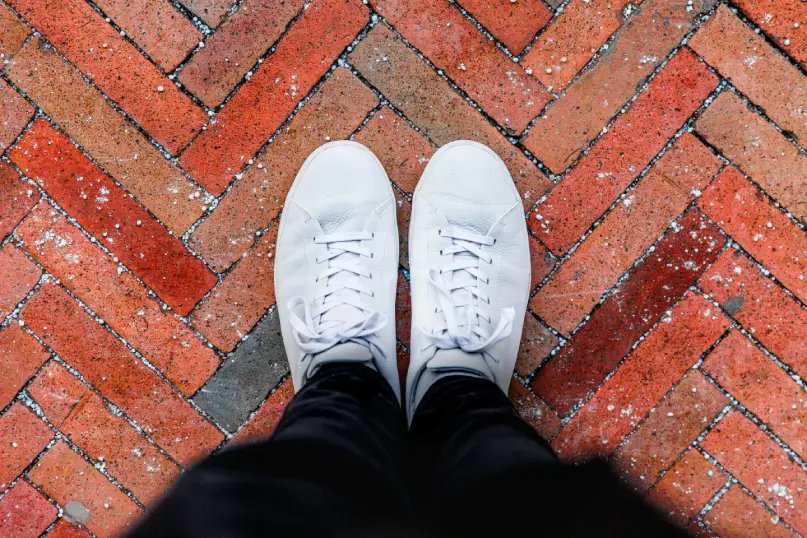
Good Smelling Shoes With Rinse
While these home remedies are effective, sometimes you need a more consistent and professional solution to keep your shoes smelling great. That’s where Rinse comes in. Rinse offers a convenient solution for for your clothes to take the load off while you care for your shoes.
With Rinse’s easy pick-up and delivery service, you can have your clothes taken care of without any hassle. Rinse’s commitment to quality means you can trust that your clothes will come back looking and smelling better than ever.
For more tips on shoe care, check out these helpful guides on shoe hacks for fall and how to wash shoes. To learn more about other ways to take care of your clothes, read our guides on how to get mildew smell out of clothes and how to prolong the life of your workout clothes.
By incorporating these tips into your shoe care routine and partnering with Rinse, you can ensure that your footwear remains fresh, clean, and odor-free all year round.
Contact us at Rinse today to see our skill in action.

Have laundry or dry cleaning to do?
Rinse picks up, cleans and delivers 7 days a week. Amazingly awesome. Ridiculously simple.

Introduction
Folding a fitted sheet is one of those household tasks that many people dread. The elastic corners and stretchy fabric seem to have a mind of their own, making it feel almost impossible to achieve a neat, flat fold. Yet, mastering the art of folding a fitted sheet is essential for anyone who wants to maintain a tidy and organized linen closet. A well-folded fitted sheet not only looks good but also saves space and makes it easier to find matching sheets when you need them.
In this article, we’ll explore the most effective techniques for folding a fitted sheet, breaking it down into manageable steps that anyone can follow. We’ll also provide tips on storing fitted sheets to keep them looking neat, along with additional tricks to help you perfect your folding skills. Let’s dive in!
How To Fold a Fitted Sheet In 4 Steps
Folding a fitted sheet doesn’t have to be a frustrating experience. With the right approach, you can transform that unruly piece of fabric into a tidy rectangle that fits perfectly in your linen closet. Here’s how to do it in four simple steps:
1. Gather the Corners
Start by laying the fitted sheet on a flat surface, such as a bed or table, with the elastic facing up. Find the two adjacent corners at one end of the sheet. Place one hand inside each corner, so that your fingers are holding the seams where the elastic meets the fabric. Once you have a firm grip on these corners, bring your hands together and fold one corner over the other, so they are nested inside each other.
This step helps create a foundation for the rest of the folding process by ensuring the corners are aligned.
2. Tuck the Corners Together
Next, move to the opposite end of the sheet and repeat the process with the other two corners. Now you should have two “pockets” formed by the nested corners on each side of the sheet. Take the corners you’ve already folded together and tuck them into the remaining two corners. This will result in all four corners being neatly folded into a single bundle.
At this point, your fitted sheet should resemble a loose rectangle with the elastic edges tucked in.
3. Flatten and Create a Rectangle
With the corners now tucked together, lay the sheet flat on your surface again. Smooth out any wrinkles or bunching, and use your hands to shape the sheet into a more defined rectangle. The key is to ensure the elastic edges are hidden inside the folds, creating a clean, flat surface on top.
4. Fold the Rectangle
Finally, fold the rectangle into a smaller, more manageable size that will fit neatly in your linen closet. Start by folding the sheet in half lengthwise, then fold it in half again. Depending on the size of your sheet, you may need to fold it one or two more times until you achieve a compact rectangle.
Now, your fitted sheet is ready to be stored away, neatly folded and organized.

How To Store A Fitted Sheet
Once you’ve mastered folding your fitted sheets, the next step is storing them in a way that is easy to access. Here are some tips for organizing your linen closet or storage space effectively:
1. Categorize and Label
One of the best ways to keep your linen closet organized is to categorize your sheets by size (twin, queen, king, etc.) and type (fitted sheet, flat sheet, pillowcase). Label each shelf or storage bin accordingly, so you can quickly find what you need without rummaging through piles of linens.
Consider storing complete sheet sets together, with the fitted sheet, flat sheet, and pillowcases all neatly folded and stacked. This will save you time when it comes to making the bed.
2. Use Storage Bins
Storage bins are a great way to keep your folded fitted sheets organized and protected from dust. Choose bins that are the right size for your closet and stack them on shelves for easy access. Clear bins work well because you can see what’s inside without having to open them and you can also add labels for even better organization.
Storing your sheets in bins also helps keep them fresh, as they are less likely to be exposed to air and moisture that can cause them to become musty.

4 Additional Tips And Tricks For Folding Fitted Sheets
Even with a clear process in place, folding fitted sheets can still be a bit tricky. Here are a few additional tips and tricks to help you tackle the task with ease:
1. Use the Buddy System
If you find folding fitted sheets difficult on your own, try enlisting the help of a friend or family member. With two people, the process becomes much easier, especially when it comes to gathering and tucking the corners. One person can hold the sheet while the other folds, making it quicker and more manageable.
2. Identify Corners
Before you start folding, take a moment to identify the corners of your fitted sheet. The corners with the most pronounced elastic are the ones you’ll need to fold together first. Knowing where these corners are will save you time and prevent unnecessary frustration during the folding process.
3. Place Sheets in a Basket
If you’re short on time and can’t fold your sheets immediately after washing, consider placing them in a basket until you’re ready. This will prevent them from getting wrinkled or tangled, making the folding process easier when you do get around to it. Plus, a basket is a convenient way to keep your sheets together in one place.
4. Practice Regularly
Like any skill, folding fitted sheets gets easier with practice. The more you do it, the more comfortable you’ll become with the process. Set aside a few minutes each week to practice folding your fitted sheets, and soon you’ll be able to do it quickly and effortlessly.

Keep Your Fitted Sheets Folded And Clean With Rinse
While folding fitted sheets is an important skill to master, keeping them clean and well-maintained is equally crucial. That’s where Rinse comes in. Rinse offers professional laundry and dry-cleaning services that ensure your fitted sheets are not only clean but also folded to perfection.
With Rinse, you can enjoy the convenience of having your bed sheets and linens expertly cleaned, folded, and delivered right to your door. Our services are designed to take the hassle out of laundry, allowing you to focus on the things that matter most. Plus, our eco-friendly cleaning methods mean you can feel good about choosing a service that cares for both your linens and the environment.
Discover more about how Rinse can help you keep your linens in top shape by visiting the following links:
By choosing Rinse, you can ensure that your fitted sheets are always ready for your next use.
Contact us at Rinse today to see our skill in action.

Have laundry or dry cleaning to do?
Rinse picks up, cleans and delivers 7 days a week. Amazingly awesome. Ridiculously simple.

Introduction
The lingering smell of cigarette smoke can be an intrusive and unwelcome presence in your wardrobe. Even after washing, this stubborn odor can cling to fabrics, making your clothes feel less fresh and more unpleasant to wear. Whether you’re dealing with the scent of cigarettes, cigars, or general smoke, eliminating these smells from your clothing is essential for maintaining a clean and comfortable wardrobe.
This article will provide you with a comprehensive guide to removing smoke odors from your clothes. From washing techniques to unconventional methods and the ultimate convenience of Rinse's dry cleaning services, you'll learn how to restore your garments to a fresh, smoke-free state. Let’s dive into the steps you can take to reclaim the freshness of your wardrobe.
Washing Methods: How to Remove Cigarette Smell
Washing your clothes is often the most straightforward way to remove cigarette odors, but there are specific steps you can take to ensure the smell is eliminated. Here’s how to do it effectively:
1. Choose the Best Laundry Detergent: Start by selecting a laundry detergent specifically designed to tackle tough odors. Look for products that are labeled as an “odor eliminator” or “odor remover.” These detergents are formulated with powerful agents that break down and neutralize the smoky odor rather than just masking it.
2. Adjust Water Temperature: Washing clothes in hot water can help to break down the smoke particles that are clinging to the fabric. However, it’s essential to check the care labels on your garments, as some fabrics may shrink or become damaged in high temperatures. If hot water is not suitable, lukewarm water can also be effective, especially when combined with the right detergent.
3. Add White Vinegar: White vinegar is a natural odor neutralizer that can work wonders on cigarette smells. Add one cup of white vinegar to your washing machine’s rinse cycle. Vinegar helps to neutralize the odor without leaving any residue on your clothes. It’s a safe and effective way to boost the odor-fighting power of your wash.
4. Use a Scent Booster: To ensure your clothes come out smelling fresh, consider adding a laundry scent booster to your wash. Scent boosters are designed to infuse your clothes with a pleasant fragrance that lasts long after the wash. These products can help mask any residual smoke odors that might remain after washing.
5. Utilize a Dry Sheet: Finally, place a dry sheet in the dryer when drying your clothes. Dry sheets are infused with fragrance and can help to further neutralize any lingering odors during the drying process. Opt for a dry sheet with a scent that complements the scent booster used during washing for a cohesive and pleasant fragrance.

How to Get Cigarette Smell Out of Clothes Without Washing
Sometimes, washing isn’t an option, whether due to time constraints or the delicacy of the garment. Fortunately, there are alternative methods to remove smoke odors without using a washing machine:
-
Airing Out Clothes: Hang your clothes outside in a well-ventilated area, preferably in the sun. Fresh air and sunlight can naturally help to dissipate the smoke odor from the fabric. The UV rays from the sun can also help to kill any bacteria that may be contributing to the smell.
-
Using Fabric Sprays: Fabric sprays specifically designed to remove odors can be an effective solution. These sprays work by neutralizing the odor molecules, leaving your clothes smelling fresh. Simply spray the fabric lightly and let it air dry.
-
Placing Garments in a Freezer: It might sound unconventional, but placing your clothes in a freezer can help to eliminate odors. The cold temperature can neutralize the odor-causing bacteria. Seal the garments in a plastic bag before placing them in the freezer to avoid any frost damage.
-
Baking Soda Absorption: Baking soda is a powerful odor absorber. Sprinkle it generously on your clothes and let it sit for a few hours before shaking it off. This method is especially useful for items that can’t be washed frequently, like coats or suits.

5 Alternative Methods to Get Rid of Cigarette or Smoke Smell
If you're looking for other ways to tackle the persistent smell of smoke, here are some effective alternative methods:
-
Vinegar: Vinegar isn’t just for washing; it can be used directly on garments as well. Mix equal parts water and vinegar in a spray bottle and lightly mist your clothes. Vinegar is a great neutralizer, and the smell will dissipate as it dries.
-
Lemon Juice: Lemon juice has natural deodorizing properties and can leave a fresh, citrusy scent behind. Mix one part lemon juice with two parts water and spray your clothes. This method is especially effective for lighter fabrics that won’t stain from the lemon juice.
-
Charcoal: Activated charcoal is another powerful odor absorber. Place a few pieces of charcoal in a breathable bag or container and store it with your clothes. The charcoal will absorb the smoke odor over time, leaving your garments smelling fresh.
-
Coffee Grounds: Like baking soda, coffee grounds can absorb odors effectively. Place your clothes in a bag with a small container of dry coffee grounds and seal it. Leave it for a few hours or overnight to allow the coffee to absorb the smoky scent.
-
Newspaper: Newspaper can be surprisingly effective at absorbing odors. Crumple up some sheets and place them inside your clothes or in a bag with your garments. Leave them for a few hours or overnight to help draw out the smoke smell.

Stress-Free and Smoke-Free Results? Try Rinse
Eliminating the smell of smoke from your clothes can be a time-consuming and sometimes frustrating task. For those looking to save time and ensure the best results, Rinse offers an effortless solution. Our expert dry cleaning and laundry services can help remove stubborn odors, including cigarette smoke, from your garments.
The Rinse process is simple and convenient. Just schedule a pickup, and our team will collect your clothes and return them fresh and clean. Our services are not only effective but also eco-friendly, ensuring that your clothes are treated with the utmost care.
Whether you’re dealing with a smoky wardrobe or just looking to freshen up your clothes, Rinse is here to help. Let us take the hassle out of laundry day so you can enjoy a wardrobe that breathes freshness and cleanliness.
For more tips on how to keep your clothes smelling fresh, check out these related articles:
Contact us at Rinse today to see our skill in action.

Have laundry or dry cleaning to do?
Rinse picks up, cleans and delivers 7 days a week. Amazingly awesome. Ridiculously simple.
Topics
Rinse Drop
We offer pickup and delivery if you can’t be present between 8pm and 10pm.
Our Valet will pick up or deliver your order to your doorstep or concierge, at which point you’ll receive a text with a photo showing where your items were left.
You can enable Rinse Drop on any (or all) of your orders.


